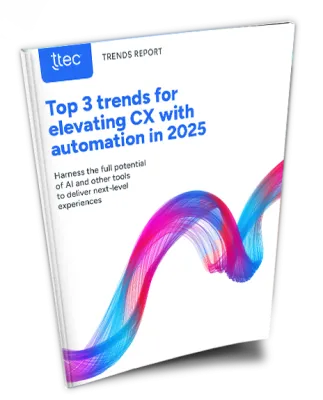There’s no denying the importance of winning over shoppers during the consideration and buying phases of the customer journey, but retailers’ focus on customer experience (CX) shouldn’t end there.
The post-purchase and return-related phases play an increasingly important role in customer satisfaction and loyalty, so brands need to have the right people and technology in place to meet customers’ needs in those moments. Brands that aren’t focusing on these touchpoints are missing opportunities to improve customer satisfaction, foster repeat business, and grow revenue.
Don’t underestimate the impact of returns
Returns have a major effect on the industry, according to a recent report by UPS and the National Retail Federation. Retailers estimated 17% of their annual sales in 2024 will be returned, with total returns reaching $890 billion last year. Most retailers (69%) planned to prioritize upgrading their return capabilities in the next six months.
With return-related interactions on the rise, retailers should be using these touchpoints to deepen their relationship with customers. This is especially true for e-commerce brands, which tend to see a higher return rate than brick-and-mortar stores.
Turn potential detractors into active promoters
Retailers’ handling of returns plays a key role in retaining customers. If returning an item is arduous, inconvenient, or contentious, customers are likely to make their future purchases elsewhere. Reduce churn by making returns easy.
Empower customers to start the return process when and how they want by offering self-service options. Not every interaction requires a human touch; delegate those that don’t to chatbots, IVAs, and autonomous AI agents that can handle simple requests quickly. This frees up associates to focus on more nuanced interactions.
Establishing automated self-service return portals, providing instant refunds to repeat buyers and loyalty program members, and otherwise streamlining the returns process will boost associate efficiency, reduce costs, and improve customer satisfaction. Also important: make it easy for automation to hand off to a human associate when needed.
Hybrid retailers that have an online and brick-and-mortar presence should embrace an omnichannel process to make returns seamless for customers. Give shoppers the option, for instance, of buying a product online but returning it in-store.
It’s important for return-related interactions to be quick but they also need to be empathetic. Customers trying to make a return are already entering an interaction dissatisfied, which can heighten emotions and add a sense of urgency, so associates need to come from a place of understanding.
When associates are empathetic and can offer a quick and easy resolution, interactions that could have been relationship enders are transformed into relationship builders.
Put insights to work
The best way to serve customers is to understand them, and the best way to do that is diving deeply into your data. Get a firm grasp on how returns-related interactions are going (what customers like, what frustrates them, where associates need help) by tapping into data in your contact center.
Use conversation AI to listen to all interactions and identify patterns and trends. Then put those AI-powered insights in the hands of quality experts who can use them to inform business decisions and suggest best next steps.
When a high-end retailer wanted a clearer picture of customer sentiment, we worked with our strategic partner LevelAI to help. We implemented our TTEC Insights solution, which includes LevelAI technology that listens to and analyze 100% of customer interactions across all customer support channels.
Among the insights it uncovered:
- 10% of interactions about returns were customers asking specifically about return labels
- 17% of those with return enquiries were repeat contacts
Armed with those insights, our quality experts took a closer look at the customer journey and recommended letting customers print their own return labels from the company website. It was a relatively simple change that made a big impact, improving CX and reducing contacts.
Maximize the value of returns interactions
The returns process is a touchpoint where retailers should consider introducing (or augmenting) service-to-sales efforts. There’s great potential to uncover hidden sales opportunities during these interactions – but the timing, delivery, and customization of sales offers are key.
Nothing is more off-putting than an unwanted sales attempt that feels forced, especially when customers making returns may already be frustrated. AI can identify which types of offers are most likely to resonate with the right customers at the right moments. Often, a returns resolution can be an upsell or cross-sell; AI can eliminate the guesswork and identify those opportunities.
At TTEC, we help brands use conversational AI to listen to 100 percent of interactions to understand customer sentiment around returns. That enables us to craft a customized sales pitch based not only on the return intent but, more specifically, based on the reason for the return.
One of AI’s greatest benefits is the huge volume of data and insights it can produce. We leverage AI-powered tools to not only identify patterns but also to create associate training modules. Our Discovery Wizard and Content Wizard take information from all conversations to create customized trainings and coaching bots that let associates practice and master skills. We also measure the execution with advanced reporting, making changes as needed.
Brands that aren’t maximizing the value of every return-related interaction with an AI-powered service to sales strategy could be leaving money on the table.
Combat fraud with intelligent automation
The return process, unfortunately, can be ripe for fraud. AI can help here, too.
Fraud is an expensive problem for retailers, and it’s often tied to returns. In 2023, 7% of all returns made at retailers were fraud or abuse and merchants lost a total of $101 billion due to return abuse and fraud, according to Ekata.
AI-powered tools can predict and identity fraud instances through the use of model training, labelling, and machine learning models. They can find patterns, flag anomalies, and predict actions in real time.
This technology, working in tandem with human fraud investigators who know your brand well, can provide the always-on vigilance brands need to protect customers and brand reputation.
Working with an expert CX partner that specializes in retail and e-commerce is great way to tap into the AI-powered insights, service-to-sales, and fraud-fighting tools you need to elevate your CX without breaking the bank.

















